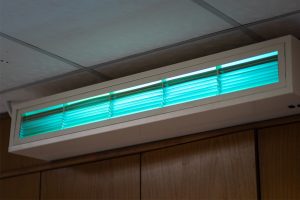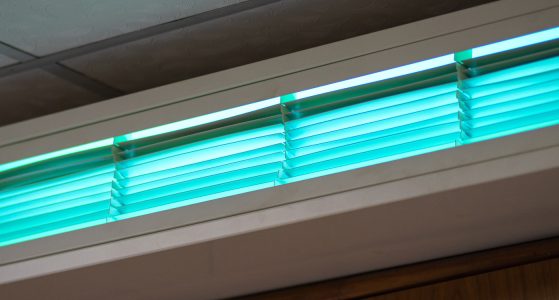Far UVC lamps are ultraviolet lamps designed to emit wavelengths in a range of 222 nanometers (nm) as opposed to the typical range of standard germicidal 254 nm UV lamps. There is an increase in Far UVC light technology interest and accessibility with research showing an effective sweet spot to kill germs with people present. Healthcare facilities and practitioners are discovering the benefits of far UVC light with increased safety and high efficacy.
Far UVC 222nm lamps with the right lamp design can prevent the emission of the longer and more harmful wavelengths, providing the same effectiveness in killing viruses, bacteria, and antibiotic-resistant bacteria.
Far UVC Lamps are Increasing in Usage
UVC lamps have been used for decades as scientists have known that UVC radiation rapidly and effectively kills bacteria, viruses, and microbes. UVC lamps have been shown to effectively eliminate up to 97.7% of harmful pathogens in hospital operating rooms as reported by Technology Networks and many other proven scientific studies.
So why would health practitioners or other users of UVC disinfection technology want to make the switch to Far UVC lamps? Far UVC lamps offer increased safety over standard 254 nm UV lamps without jeopardizing effectiveness.
Increased Safety with Far UVC Lamps
Conventional UVC germicidal lamps are effective at eliminating harmful pathogens in the air, in water, and on surfaces, although they cannot be used in occupied spaces due to potential health hazards. Standard 254 nm UVC germicidal lamps are known to be dangerous to human skin and eyes, making it important that those UV germicidal systems be closed systems with protection mechanisms. People should also wear proper personal protective equipment (PPE) when servicing or installing traditional UV disinfection systems.
Far UVC lamps, on the other hand, emit shorter wavelengths that significantly reduce the risk of human exposure, and some experts might even suggest that risk is reduced to zero. This allows for Far UVC light disinfection systems to run constantly without causing harm as opposed to traditional UVC lamps that can only operate in unoccupied spaces.
Far UVC Light Disinfection Effectiveness
Far UVC light at 222 nm allows for safe, continual disinfection and is highly effective at deactivating and destroying pathogens. Far UVC lamps in line of sight disinfection systems can destroy airborne pathogens at the speed of light. According to an article published at UVReporter.com, far UVC light deactivates and destroys pathogens. 254nm light is proven highly effective at inactivating pathogens, although in some cases those pathogens could be reconstituted through a photoreactivation process. Far UVC light is known to deactivate and destroy many pathogens including bacteria, viruses, fungi, protozoa, mold, and other harmful microorganisms.
While far UVC technology has not had the extensive research that traditional UVC wavelengths have had, several studies do suggest that far UVC radiation at 222 nm is effective at destroying a wide range of harmful pathogens. This includes viruses such as influenza, (H1N1), alpha and beta coronaviruses, including the SARS-CoV-2 virus that causes COVID-19, and adenovirus, according to a scientific report, Far-UVC light: A new tool to control the spread of airborne-mediated microbial diseases.
In another recent study published in March 2022, Far-UVC (222 nm) efficiently inactivates an airborne pathogen in a room-sized chamber, scientists at several different universities came together to test the efficacy of far UVC light in a large room-sized chamber with a ventilation rate the same as a typical office or home, which is about three air changes per hour. The experiment included continuously spraying an aerosol mist of S. aureus bacteria into the room, a microbe that is slightly less sensitive than coronaviruses to far UVC light to provide a conservative model. Far UVC lamps were turned on in commercially overhead systems and in just five minutes, 98% of the airborne microbes were inactivated even though they were continually being sprayed into the room.
This same study verified the high efficacy of far UVC lamps which is often measured in terms of equivalent air changes per hour, with this study producing an equivalent of 184 air exchanges per hour. This far exceeds other approaches to disinfecting occupied spaces indoors where an equivalent of 5 to 20 air changes per hour is typical.
A Future for Far UVC Light
Given the safety and efficacy of far UVC light at 222 nm, the future looks bright for increasing the usage of far UVC lamps which can provide disinfection of the air with any excess radiation extending to disinfecting surfaces. This provides a big advantage of far UVC technology over traditional 254 nm UV lamps.
LAMP PRODUCT DATA:
UV Germicidal LampsLAMP APPLICATIONS:
UV Germicidal Applications
LightSources offers high-tech, high-quality UVC germicidal lamps used in air, water, and surface disinfection systems worldwide. Our lighting engineers offer custom design and engineering to meet your disinfection system requirements with custom phosphor blends to meet specific emissisons. Contact us to learn more about our germicidal UVC lamp solutions including far UVC lamps currently in development.
This post is also available in:
 Chino simplificado
Chino simplificado Inglés
 Alemán
Alemán


